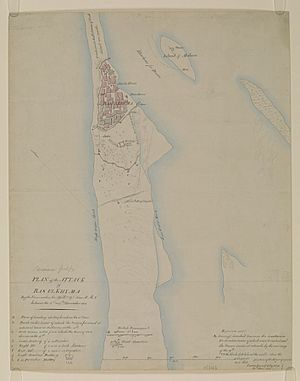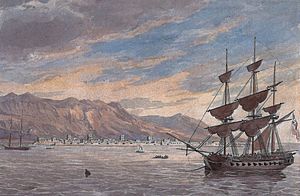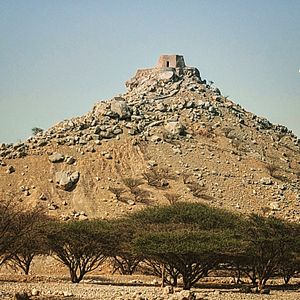Persian Gulf campaign of 1819 facts for kids
Quick facts for kids Persian Gulf campaign of 1819 |
|||||||
|---|---|---|---|---|---|---|---|
| Part of Piracy in the Persian Gulf | |||||||
 Plan of the attack of Ras Ul Khyma by the force under Sir Willm. Gr. Keir K.M.T., between 3-9 December 1819 |
|||||||
|
|||||||
| Belligerents | |||||||
|
Supported by |
|
||||||
| Commanders and leaders | |||||||
| Strength | |||||||
| Ras Al Khaimah: Dhayah: Further operations: |
Ras Al Khaimah: Dhayah: Further operations: |
||||||
| Casualties and losses | |||||||
| Ras Al Khaimah: 5 killed and wounded Dhayah: 4 killed 16 wounded Further operations: None |
Ras Al Khaimah: 400 killed and wounded Dhayah: Unknown Further operations: Unknown 10 vessels burned |
||||||
The Persian Gulf campaign of 1819 was a military operation by the British. It was mainly against the Al Qasimi maritime forces in the Persian Gulf. The British expedition started from Bombay, India, in November 1819. Its goal was to attack Ras Al Khaimah. The campaign was a success for the British. It led to the signing of the General Maritime Treaty of 1820. This treaty was between the British and the leaders of what was then called the "Pirate Coast." After the treaty, this area became known as the "Trucial Coast." Today, this land makes up much of the United Arab Emirates.
Contents
Why the Campaign Happened
For many years, British ships faced problems with the Al Qasimi. In 1809, a British force went to Ras Al Khaimah. This led to a peace treaty between the British and Hussan Bin Rahmah, the Al Qasimi leader. However, this peace agreement ended in 1815.
After the treaty broke down, more attacks on ships happened. For example, in 1815, Al Qasimi captured a British Indian ship near Muscat. Most of its crew were killed. On January 6, they captured another ship, the Deriah Dowlut, and killed 17 of its 38 Indian crew members. In 1816, three British-flagged Indian merchant ships were taken in the Red Sea. Most of their crews were also killed.
The British sent a ship, Ariel, to Ras Al Khaimah to investigate. The Al Qasimi denied being involved in these attacks. They said they did not consider all Indian people as British subjects.
Later, a small British squadron fired at four Al Qasimi ships. But they were too far away, and the attack did not work. After this, more raids on shipping followed. One Arab ship, flown under English colors, was even taken close to Bombay.
By the end of 1818, Hassan bin Rahmah tried to make peace with Bombay. But his offers were refused. At this time, the Al Qasimi had about 60 large boats in Ras Al Khaimah. Each boat could carry 80 to 300 men. They also had 40 smaller boats in other nearby ports.
Some historians, like Sultan bin Mohammed Al Qasimi, have a different view. He suggests that the British East India Company might have wanted to control Arab trade with India. He argues that the British used these incidents as a reason for war. An official from Bombay, F. Warden, also believed that other factors were at play. These included the influence of the Wahhabi group on the Al Qasimi. He also pointed to the East India Company's involvement in local affairs.
The Campaign Begins
On November 3, 1819, the British started their expedition against the Al Qasimi. Major-General William Keir Grant led the force of 3,000 soldiers. They sailed to Ras Al Khaimah.
The British also asked Said bin Sultan of Muscat for help. They offered to make him ruler of the "Pirate Coast" if he joined them. He agreed and sent 600 men and two ships. The British naval force included ships like Liverpool, Eden, and Curlew. The Bombay Marine (part of the East India Company) also sent six armed ships.
Major-General Grant commanded about 3,000 troops. This included 1,645 European soldiers and marines. There were also 1,424 Indian soldiers, called sepoys.
The British forces gathered off Ras Al Khaimah on November 25 and 26. On December 2 and 3, troops landed south of the town. They set up cannons and mortars. On December 5, the town was attacked from both land and sea. The bombardment of the town began on December 6. On December 7, two large 24-pound cannons from the ship Liverpool were added to the land attack.
The attack on Ras Al Khaimah was quick. The British had only five casualties (killed or wounded). The Al Qasimi, however, reportedly suffered between 400 and 1000 casualties.
The Fall of Dhayah Fort
After Ras Al Khaimah fell, British ships blocked the port of Rams to the North. This town was also found empty. Its people had moved to the strong hill-top fort of Dhayah.
On December 18, the British landed troops. They fought their way through date farms to Dhayah Fort on December 19. Inside the fort, 398 men and 400 women and children were trapped. They had no clean water, no proper toilets, and little shade from the sun. They held out for three days under heavy fire from cannons.
The two large 24-pound cannons from HMS Liverpool were brought from the coast. Each gun weighed over two tons. After two hours of constant firing, the fort's walls broke. The last of the Al Qasimi surrendered at 10:30 AM on December 22.
Many people in the fort were farmers who had fled there. Out of the 398 people who surrendered, only 177 were identified as fighters. The British flag was briefly raised over the fort before it was blown up. British losses at Dhayah included one officer and three men killed, and sixteen wounded.

The British then blew up the town of Ras Al Khaimah. They left a group of 800 Indian soldiers and artillery there. They also visited Jazirat Al Hamra, which was empty. They went on to destroy the forts and large ships in other towns. These included Umm Al Qawain, Ajman, Fasht, Sharjah, Abu Hail, and Dubai. Ten ships that had hidden in Bahrain were also destroyed. The Royal Navy had no casualties during these actions.
The Treaty and What Happened Next
After the campaign, the leaders of these communities were either captured or surrendered. A new agreement was proposed to ensure peace in the future. This was the General Treaty of Maritime Peace of 1820. The treaty begins with a prayer for peace.
Sir William Keir Grant, the UK's representative, oversaw the treaty. It stopped piracy in the Persian Gulf. It also banned slavery. All ships that could be used had to be registered with British forces. They had to fly special red and white flags. These flags are still used today as the flags of the different emirates.
The treaty was signed by the leaders of Khatt and Falaya, Jazirah Al Hamra, Abu Dhabi, Rams and Dhayah, Dubai, Sharjah, Ajman, and Umm Al Qawain. This treaty led to a long period of peace and growth. It helped coastal trading communities to become successful. Some of these communities later grew into major global cities.


